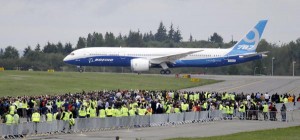 A longer version of Boeing Co’s Dreamliner successfully completed its first flight on Tuesday, passing a key milestone for a plane expected to be more profitable for Boeing to sell and its customers to operate than the current production model.
A longer version of Boeing Co’s Dreamliner successfully completed its first flight on Tuesday, passing a key milestone for a plane expected to be more profitable for Boeing to sell and its customers to operate than the current production model.
The 787-9 jet, which landed at 4:18 pm PST (2318 GMT) at Boeing Field in Seattle, has room for 290 passengers, 40 more than the original 787-8 jetliner, and has about 300 more nautical miles of range.
The flight brought no immediate bad news for a plane that has been plagued by problems from minor issues with its brakes to electrical panel fires and overheating batteries that caused the 787-8 fleet to be grounded for three months earlier this year while Boeing redesigned the battery system.
“We call that a no-squawk flight,” Capt. Mike Bryan, senior project pilot for the 787-9, said after landing, referring to minor problems that often crop up on new planes.
He said there were some small “setting up” messages that were present before the flight, but these were not new issues. The messages don’t prevent the flight but need to be checked before take off, Boeing later said.
“We have nothing to work that’s new and we’re ready for another flight, as quick as we can go,” Bryan said. He later said the next test flight was likely to occur on Thursday.
Bryan and co-test pilot Randy Neville, chief 787 test pilot, said they worked through numerous tests during the flight, including checking a stick shaker test for stalls, an alert system that warns of potentially perilously low speed.
“The airplane just did exactly as we expected,” Neville said. “There were no surprises.”
The plane took off at 11:02 am from Paine Field in Everett, Washington, near where it was assembled at Boeing’s wide-body plane factory.
Boeing has unfilled orders for 936 Dreamliners, worth about $217 billion at list prices, or nearly eight years worth of production at its target construction rate of 10 per month, which it aims to hit by year’s end.
About 41 percent of the orders, or 388 planes, are for the 787-9. Boeing began selling an even longer version of the jet, the 787-10, in June, for which it has garnered 50 orders so far. The rest of the orders are for the 787-8.
In its maiden voyage the 787-9 was scheduled to run detailed tests of its flight controls, part of a nine-month testing program. The aircraft used for the tests will eventually be delivered to Air New Zealand in mid-2014, Boeing said.
The jet flew at a speed of up to 366 knots (421 mph) and altitude of 20,000 feet (6,096 meters), according to flight tracking website Flightaware.com. The trip took it over Puget Sound and then over the eastern part of Washington state.
CSM
Leave a Reply
You must be logged in to post a comment.